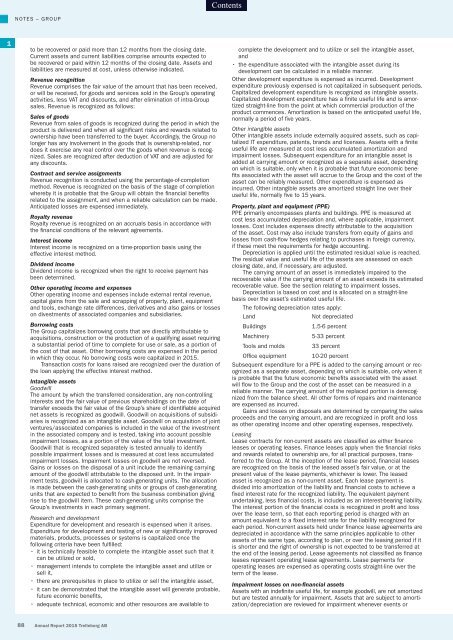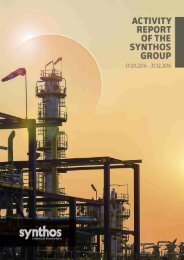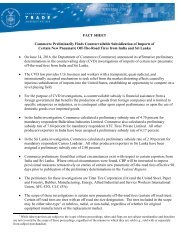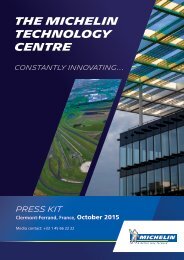We seal damp and protect
1o0Rrof
1o0Rrof
You also want an ePaper? Increase the reach of your titles
YUMPU automatically turns print PDFs into web optimized ePapers that Google loves.
NOTES – GROUP<br />
1<br />
18<br />
19<br />
20<br />
21<br />
22<br />
23<br />
24<br />
25<br />
26<br />
to be recovered or paid more than 12 months from the closing date.<br />
Current assets <strong>and</strong> current liabilities comprise amounts expected to<br />
be recovered or paid within 12 months of the closing date. Assets <strong>and</strong><br />
liabilities are measured at cost, unless otherwise indicated.<br />
Revenue recognition<br />
Revenue comprises the fair value of the amount that has been received,<br />
or will be received, for goods <strong>and</strong> services sold in the Group’s operating<br />
activities, less VAT <strong>and</strong> discounts, <strong>and</strong> after elimination of intra-Group<br />
sales. Revenue is recognized as follows:<br />
Sales of goods<br />
Revenue from sales of goods is recognized during the period in which the<br />
product is delivered <strong>and</strong> when all significant risks <strong>and</strong> rewards related to<br />
ownership have been transferred to the buyer. Accordingly, the Group no<br />
longer has any involvement in the goods that is ownership-related, nor<br />
does it exercise any real control over the goods when revenue is recognized.<br />
Sales are recognized after deduction of VAT <strong>and</strong> are adjusted for<br />
any discounts.<br />
Contract <strong>and</strong> service assignments<br />
Revenue recognition is conducted using the percentage-of-completion<br />
method. Revenue is recognized on the basis of the stage of completion<br />
whereby it is probable that the Group will obtain the financial benefits<br />
related to the assignment, <strong>and</strong> when a reliable calculation can be made.<br />
Anticipated losses are expensed immediately.<br />
Royalty revenue<br />
Royalty revenue is recognized on an accruals basis in accordance with<br />
the financial conditions of the relevant agreements.<br />
Interest income<br />
Interest income is recognized on a time-proportion basis using the<br />
effective interest method.<br />
Dividend income<br />
Dividend income is recognized when the right to receive payment has<br />
been determined.<br />
Other operating income <strong>and</strong> expenses<br />
Other operating income <strong>and</strong> expenses include external rental revenue,<br />
capital gains from the sale <strong>and</strong> scrapping of property, plant, equipment<br />
<strong>and</strong> tools, exchange rate differences, derivatives <strong>and</strong> also gains or losses<br />
on divestments of associated companies <strong>and</strong> subsidiaries.<br />
Borrowing costs<br />
The Group capitalizes borrowing costs that are directly attributable to<br />
acquisitions, construction or the production of a qualifying asset requiring<br />
a substantial period of time to complete for use or sale, as a portion of<br />
the cost of that asset. Other borrowing costs are expensed in the period<br />
in which they occur. No borrowing costs were capitalized in 2015.<br />
Transaction costs for loans raised are recognized over the duration of<br />
the loan applying the effective interest method.<br />
Intangible assets<br />
Goodwill<br />
The amount by which the transferred consideration, any non-controlling<br />
interests <strong>and</strong> the fair value of previous shareholdings on the date of<br />
transfer exceeds the fair value of the Group’s share of identifiable acquired<br />
net assets is recognized as goodwill. Goodwill on acquisitions of subsidiaries<br />
is recognized as an intangible asset. Goodwill on acquisition of joint<br />
ventures/associated companies is included in the value of the investment<br />
in the associated company <strong>and</strong> is tested, taking into account possible<br />
impairment losses, as a portion of the value of the total investment.<br />
Goodwill that is recognized separately is tested annually to identify<br />
possible impairment losses <strong>and</strong> is measured at cost less accumulated<br />
impairment losses. Impairment losses on goodwill are not reversed.<br />
Gains or losses on the disposal of a unit include the remaining carrying<br />
amount of the goodwill attributable to the disposed unit. In the impairment<br />
tests, goodwill is allocated to cash-generating units. The allocation<br />
is made between the cash-generating units or groups of cash-generating<br />
units that are expected to benefit from the business combination giving<br />
rise to the goodwill item. These cash-generating units comprise the<br />
Group’s investments in each primary segment.<br />
Research <strong>and</strong> development<br />
Expenditure for development <strong>and</strong> research is expensed when it arises.<br />
Expenditure for development <strong>and</strong> testing of new or significantly improved<br />
materials, products, processes or systems is capitalized once the<br />
following criteria have been fulfilled:<br />
• it is technically feasible to complete the intangible asset such that it<br />
can be utilized or sold,<br />
• management intends to complete the intangible asset <strong>and</strong> utilize or<br />
sell it,<br />
• there are prerequisites in place to utilize or sell the intangible asset,<br />
• it can be demonstrated that the intangible asset will generate probable,<br />
future economic benefits,<br />
• adequate technical, economic <strong>and</strong> other resources are available to<br />
complete the development <strong>and</strong> to utilize or sell the intangible asset,<br />
<strong>and</strong><br />
• the expenditure associated with the intangible asset during its<br />
development can be calculated in a reliable manner.<br />
Other development expenditure is expensed as incurred. Development<br />
expenditure previously expensed is not capitalized in subsequent periods.<br />
Capitalized development expenditure is recognized as intangible assets.<br />
Capitalized development expenditure has a finite useful life <strong>and</strong> is amortized<br />
straight-line from the point at which commercial production of the<br />
product commences. Amortization is based on the anticipated useful life,<br />
normally a period of five years.<br />
Other intangible assets<br />
Other intangible assets include externally acquired assets, such as capitalized<br />
IT expenditure, patents, br<strong>and</strong>s <strong>and</strong> licenses. Assets with a finite<br />
useful life are measured at cost less accumulated amortization <strong>and</strong><br />
impairment losses. Subsequent expenditure for an intangible asset is<br />
added at carrying amount or recognized as a separate asset, depending<br />
on which is suitable, only when it is probable that future economic benefits<br />
associated with the asset will accrue to the Group <strong>and</strong> the cost of the<br />
asset can be reliably measured. Other expenditure is expensed as<br />
incurred. Other intangible assets are amortized straight line over their<br />
useful life, normally five to 15 years.<br />
Property, plant <strong>and</strong> equipment (PPE)<br />
PPE primarily encompasses plants <strong>and</strong> buildings. PPE is measured at<br />
cost less accumulated depreciation <strong>and</strong>, where applicable, impairment<br />
losses. Cost includes expenses directly attributable to the acquisition<br />
of the asset. Cost may also include transfers from equity of gains <strong>and</strong><br />
losses from cash-flow hedges relating to purchases in foreign currency,<br />
if these meet the requirements for hedge accounting.<br />
Depreciation is applied until the estimated residual value is reached.<br />
The residual value <strong>and</strong> useful life of the assets are assessed on each<br />
closing date, <strong>and</strong>, if necessary, are adjusted.<br />
The carrying amount of an asset is immediately impaired to the<br />
recoverable value if the carrying amount of an asset exceeds its estimated<br />
recoverable value. See the section relating to impairment losses.<br />
Depreciation is based on cost <strong>and</strong> is allocated on a straight-line<br />
basis over the asset’s estimated useful life.<br />
The following depreciation rates apply:<br />
L<strong>and</strong><br />
Not depreciated<br />
Buildings<br />
1.5-6 percent<br />
Machinery<br />
5-33 percent<br />
Tools <strong>and</strong> molds 33 percent<br />
Office equipment 10-20 percent<br />
Subsequent expenditure for a PPE is added to the carrying amount or recognized<br />
as a separate asset, depending on which is suitable, only when it<br />
is probable that the future economic benefits associated with the asset<br />
will flow to the Group <strong>and</strong> the cost of the asset can be measured in a<br />
reliable manner. The carrying amount of the replaced portion is derecognized<br />
from the balance sheet. All other forms of repairs <strong>and</strong> maintenance<br />
are expensed as incurred.<br />
Gains <strong>and</strong> losses on disposals are determined by comparing the sales<br />
proceeds <strong>and</strong> the carrying amount, <strong>and</strong> are recognized in profit <strong>and</strong> loss<br />
as other operating income <strong>and</strong> other operating expenses, respectively.<br />
Leasing<br />
Lease contracts for non-current assets are classified as either finance<br />
leases or operating leases. Finance leases apply when the financial risks<br />
<strong>and</strong> rewards related to ownership are, for all practical purposes, transferred<br />
to the Group. At the inception of the lease period, financial leases<br />
are recognized on the basis of the leased asset’s fair value, or at the<br />
present value of the lease payments, whichever is lower. The leased<br />
asset is recognized as a non-current asset. Each lease payment is<br />
divided into amortization of the liability <strong>and</strong> financial costs to achieve a<br />
fixed interest rate for the recognized liability. The equivalent payment<br />
undertaking, less financial costs, is included as an interest-bearing liability.<br />
The interest portion of the financial costs is recognized in profit <strong>and</strong> loss<br />
over the lease term, so that each reporting period is charged with an<br />
amount equivalent to a fixed interest rate for the liability recognized for<br />
each period. Non-current assets held under finance lease agreements are<br />
depreciated in accordance with the same principles applicable to other<br />
assets of the same type, according to plan, or over the leasing period if it<br />
is shorter <strong>and</strong> the right of ownership is not expected to be transferred at<br />
the end of the leasing period. Lease agreements not classified as finance<br />
leases represent operating lease agreements. Lease payments for<br />
operating leases are expensed as operating costs straight-line over the<br />
term of the lease.<br />
Impairment losses on non-financial assets<br />
Assets with an indefinite useful life, for example goodwill, are not amortized<br />
but are tested annually for impairment. Assets that are subject to amortization/depreciation<br />
are reviewed for impairment whenever events or<br />
88 Annual Report 2015 Trelleborg AB






